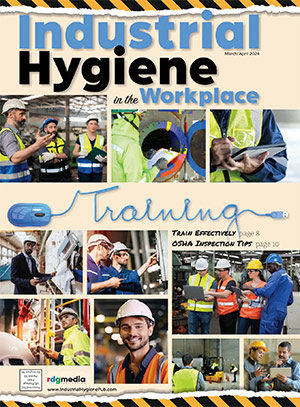The Right Resistance: Understanding Options for Chemical-Resistant Gloves

Employees where chemicals are manufactured are at high risk for hand injuries due to chemical exposure; industries also at risk for such hazards include mining, painting, construction, metalworking and welding. (Cloudyew – stock.adobe.com)
By: Barbara T. Nessinger, Editor-in-Chief
“Resistance is futile.” If you are a fan of Star Trek, you’ll understand the reference to the menacing aliens known as the Borg. And, in the case of space-age bad guys, the statement might be true. Happily, resistance to chemical exposure in the workplace is not futile; it’s entirely possible—with the right products to protect your workers.
There are many options for chemical-resistant gloves and other apparel on the market. Having access to these products—and workers’ willingness to use them on the job—is the key to helping to protect workers’ skin while addressing any personal comfort concerns.
Chemical Protection Standards
Chemical-protective gloves must meet the requirements of European standard EN 374. This standard was modified substantially in 2016. The changes became effective once they were published in the Official Journal of the European Union.
The 2016 EN ISO 374 standard ensures consistency in testing and helps users and safety professionals determine their chemical protection needs. The revised requirements are reflected in pictograms that appear on gloves and on glove dispenser boxes certified for chemical and micro-organism exposure.
EN 374 has several parts. Part one, officially referred to as EN ISO 374-1:2016, states: “Protective gloves against dangerous chemicals and microorganisms—Part 1: Terminology and performance requirements for chemical risks.” (See IHW’s in-depth analysis of this standard at https://bit.ly/3zvpWdH.)

Chemical-resistant gloves are crucial within all industries and workplaces that handle hazardous substances. (photo courtesy Honeywell)
Choosing Safety
Workers need to make a conscious decision to wear the right PPE, and chemical-resistance apparel is no exception. Employees must be given solutions that offer both operational assistance (PPE that works) and that address personal concerns (comfort, wearability) in order to make that decision. The right glove or apparel solution should help workers perform their tasks better—while staying in compliance with regulatory standards—and also offer workers a safety or health benefit.
Employees where chemicals are manufactured are obviously at risk for hand injuries due to chemical exposure. Other industries also at high risk for such hazards include mining, painting, construction and welding. Selecting the right chemical-
resistant glove for the job can be a complicated, sometimes confusing task.
You can identify a glove’s chemical protection performance by looking at its marked Type. (See chart, “Protective Glove Markings.”) The Type will tell you how many of the 18 chemicals listed in the table were tested with the glove to check its performance, as well as the expected minimal length of the protection against these chemicals. The letter code denotes the tested chemicals within the EN 374 standard.
Many glove manufacturers utilize the EN-374 TYPE A, B, C labeling system denoted on the chart. Use of the labeling system throughout a company’s products, catalogs, packaging, dispensers and training materials helps those purchasing the gloves rest assured they are getting workers the right protection for the job.
Permeation vs. Penetration
Knowing the type of chemicals employees might be exposed to in their daily tasks is critical to the selection of the types of gloves/hand protection they need. This is where a labeling system is important.
We recently asked Gil Leverne, Director, Marketing at SHOWA International, about the term “chemical permeation” and how can it be combatted in industries where chemical exposure is a risk. “Permeation is a process by which a chemical can pass through a protective film without going through pinholes, pores or other visible openings. Individual molecules of the chemical enter the film and ‘squirm’ through by passing between the molecules of the glove compound or film. This is combatted by wearing the proper hand protection within the regulated time of exposure to chemicals,” explained Leverne.
Permeation differs from the term “penetration,” when used to describe a chemical process. Permeation is described as something moving through a substance by diffusion or going through the pores of it by being spread onto it. Penetration is when a certain chemical can find its way into the pores and imperfections of a certain material.
Staying Single (Use)
Wearing single-use gloves all day can cause more skin-health problems than the dangers from which they are worn to protect in the first place. Single-use gloves envelope hands in an air-tight space. This can result in restricted airflow, causing hands to sweat, which can result in a change of the skin’s natural pH level. As the skin’s pH changes, it weakens the hand’s ability to resist bacteria, leading to more infections and longer healing times. When hand defenses are weakened, it might result in contact dermatitis. The reduced airflow of a glove can also sometimes cause trans-epidermal water loss (TWEL), which affects the skin-barrier function, making skin disease a risk.
The good news is there are single-use gloves with the technology to be more comfortable and last longer—without having workers suffer skin issues associated with them. Several new innovations have addressed these issues. To assist with pH balance, gloves can be infused on the inner surface with a pH coating that is formulated in the range of normal skin. This helps to restore and maintain an optimum pH level on the hands.
Built-in sweat-management can also help prevent discomfort and rashes, etc. Sweat-management technology solutions include gloves with absorbent, moisture-wicking liners—so workers’ hands stay dry and cool, even if wearing the same pair of gloves for hours.
Today’s safety managers must continue searching for new protective PPE products that bring worker comfort, productivity and health to the forefront. Workers have many options and the opportunity to access gloves and other apparel that will assist in their operational duties—while also addressing personal concerns.
Additional Resources:
CDC NIOSH: https://www.cdc.gov/niosh/topics/skin/default.html
OSHA: https://www.osha.gov/safetypays/estimator.html
According to the ISO website, “ISO 374-1:2016 specifies the requirements for protective gloves intended to protect the user against dangerous chemicals and defines terms to be used. If other protection features have to be covered, e.g., mechanical risks, thermal risks, electrostatic dissipation etc., the appropriate specific performance standard is to be used in addition. Further information on protective gloves standards can be found in the EN 420.” To purchase the standard, go to https://www.iso.org/standard/66421.html
IHW article on innovations in chemical-resistant PPE: https://industrialhygienepub.com/chemppe
Protective Glove Markings
The markings for protective gloves were updated in the 2016 EN 374 standard:
Type A: Protective glove with permeation resistance of at least 30 minutes each for at least six test chemicals.
Type B: Protective glove with permeation resistance of at least 30 minutes each for at least three test chemicals.
Type C: Protective glove with permeation resistance of at least 10 minutes for at least one test chemical.
Share on Socials!
Threshold Tips for Surviving a Federal OSHA Inspection
Creating Eye Wellness, On and Off the Screen
Getting Enlightened About Single-Use Gloves Improves Worker Health
Leaders in Industrial Hygiene
Council for Accreditation in Occupational Hearing Conservation (CAOHC)
Subscribe!
Sign up to receive our industry publications for FREE!









